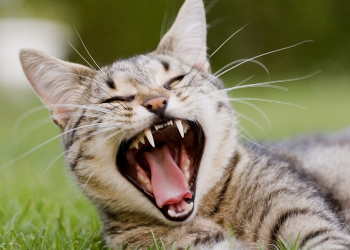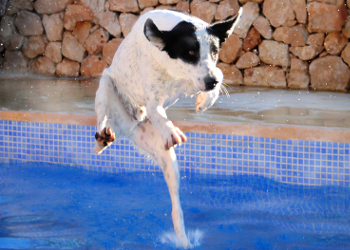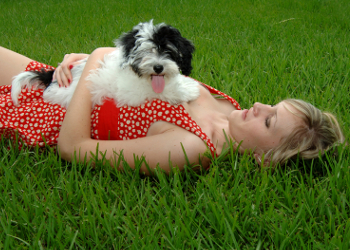Diseases #24

Nephritis is inflammation of the kidneys but the most common type of kidney inflammation is that called glomerulonephritis. This term refers to the inflammation of the glomerulous and renal parenchyma. The glomerlous is the first filtering device in the kidneys. The others are the proximal and distal tubules of the kidney. The term for the entire "factory" unit of waste disposal on a microscopic level is called the nephron. The most common cause of glomerulonephritis is the accumulation of antigen/antibody combinations. Other common causes of glomerulonephritis are heartworm, chronic dental disease, antifreeze poisoning and pyometra.
Think of the glomerulous as your kitchen drain. If the drain gets filled with food debris, the drain will not allow running water to pass through and it backs up and can even overflow and run over onto the floor! This is what happens in the glomerulous. Antigen-antibody combinations are the food debris. These combinations have a huge molecular weight and can not pass through the filtering device of the glomerulous. They clog it, impairing renal function.
Clinical signs development due to the poor filtering mechanism of the glomerulous and signs associated with renal disease. Animals may vomit, drink or urinate excessive amounts of water, have halitosis due to ammonia buildup and anorexia due to renal disease. There will often be visible blood in the urine as well as excessive protein due to poor filtration. Many dogs have glomerulonephritis secondary to another disorder and may develop chronic renal disease.
As with all renal diseases, a CBC and Chemistry profile are done to assess possible renal disease (elevated BUN and Creatinine) as well as a possible anemia. A urinalysis is always performed. Blood and excessive proteins are found on examination. The classical test to perform when suspecting glomerulonephritis is the UPC (Urine Protein Creatinine Ratio). This is extremely useful when deciding to treat it with Benazepril.
Diagnosis of glomerulonephritis is suspected when treating a primary disease that causes it. Clinical signs and lab data all go into making a diagnosis of glomerulonephritis.
Treatment is geared towards initially treating the primary cause of the glomerulonephritis. If the dog has heartworm, Immiticide® is used. If the dog has pyometra, the dog is spayed. Most animals need to be hospitalized for the treatment of the renal disease. There are varying degrees of glomerulonephritis so treatments may vary. Most animals receive intravenous fluids and diuretics to force as much fluid through the kidneys as possible, lowering the BUN and Creatinine in the process. Phosphate binders (Aluminum Hydroxide), antibiotics, vitamins and other dietary support measures will be offered. One of the most important ways to increase blood flow to the kidneys (glomerulous) is dilation of the renal blood vessels. This is done by the use of Benazepril, an ACE inhibitor. The use of this drug is based on the UPC results:
1. If the UPC is under 1, I rarely use Benazepril
2. If the UPC is between 1-2, I might use Benazepril
3. If the UPC is over 2, I always use Benazepril.
It is extremely effective in treating glomerulonephritis. The patient is discharged on it as well as diuretics, antibiotics and other supportive measures. Follow up visits including exams, blood work and urine exams are mandatory. The goal is to prevent chronic renal failure. If the urine can not concentrate, chronic renal failure will commence.
The prognosis for long term survival of glomerulonephritis depends upon successful treatment of the primary cause and preventing the animal from developing chronic failure. If those two goals are achieved the majority of animals do well as long as they are maintained on appropriate medical therapy and receive periodic exams, blood work and urine exams.

Notoedric Mange also goes by the name of Cat Scabies. It is an extremely irritating skin disease in the cat caused by the mite, Notoedres cati. Most people think that mange only can cause misery in dogs but any cat that has scaly, oozing lesions around the head and neck may have feline scabies.
All parasitic mites on dogs and cats cause damage to and reside in the hair follicle. This produces the typical scaly lesions seen. Most feline scabies will start as small oozing lesions on the ear tips but can easily extend to other parts of the body if left untreated. Feline scabies can be transmitted to dogs and humans by direct contact with an infested animal.
The most common sign is the development of oozing, scaly lesions on the ears that progress to the face and neck areas. They are extremely pruritic and cats will scratch and hyper-groom themselves resulting in hairballs. In chronic cases, the skin thickens and forms folds where secondary bacterial infections can take over.
The most commonly performed lab test is a deep skin scraping of the affected area on the cat. Under oil, the mite can easily be seen under a microscope.
Diagnosis is made by noticing the characteristic lesions around the face and by finding the mite on a deep skin scraping.
If one cat is diagnosed with the condition and it lives with other cats, all cats need to be treated. The most commonly performed treatment is shaving the affected areas of the cat and bathing it in a keratolytic shampoo such as benzoyl peroxide. A 3% lime sulfur dip is than applied and allowed to dry on the animal. Treatment can take months. Many chemicals used to treat dog scabies can be toxic to cats. Although they are off label; ivermectin, selamectin, (Revolution®) and moxidectin (Advantage Multi®) have been used successfully to treat feline scabies. It is much much easier to apply a topical than risk loss of limb trying to bathe the majority of cats! Lime sulfur dip also has an extremely offensive odor.
The prognosis for feline scabies depends upon the severity of the condition and or whether it is acute or chronic. Preventing cats from coming in contact with sick cats is important. Keeping your cats indoors is the best protection. Before any new cat is brought into the home, it should be taken to a veterinarian for a complete physical exam.

Oral injuries are a constant source of angst and pain for animals. People walk upright, animals walk on four legs. What this means is, is that their mouths are close to the ground surface. As I have said for years, dogs and cats are walking vacuum machines. They will get just about anything in their mouths. Common injuries such as: burns from chewing electrical cords, cuts and lacerations from ingesting glass and metal, severe oral infections from sticks wedged between the upper molars, needles that penetrate the soft palate, chewing rocks that fracture teeth, sharp objects that lacerate the tongue and the list goes on.
The mouth is the part of the body that is involved in prehension (the actual act of getting food into the mouth) and primary digestion by producing saliva. Other foreign bodies ingested can cause severe oral lesions that can lead to severe infections, loss of teeth and surgical repair of damaged tissue. The sinus cavities can be damaged or infected by objects that pierce the roof of the mouth.
The most common clinical sign with any foreign object lodged or damage to oral tissues is the animal constantly pawing at its face trying to extricate itself from a foreign body. If the object is sharp, such as metal or glass, there will be blood coming from the mouth mixed with saliva. If the object, such as a stick, has been in the mouth for days, there will be a foul odor. A lot of people think that is dental disease but on exam it is many times a stick lodged between the roof of the mouth and upper molars. Due to damage to the oral cavity, the animal may chew on one side of the mouth or not even eat at all if it is too painful to get food in the mouth.
Any lab work performed is proportionate to the type of oral injury. If an object penetrated the sinuses, radiographs will be taken to see if the sinuses have been infected. Most oral lesions can easily get infected so a CBC is warranted to keep an eye on the white cell count.
Tentative diagnosis of a foreign body is any dog or cat admitted that is pawing at its muzzle or face. Often the animal has to be sedated to get the diagnosis because it is too painful to open the mouth while awake. Many times the object has fallen out of the mouth yet trauma remains. At that point it is a good clinical guess that the animal had something in its mouth.
Treatment is geared towards treating the injury in the oral cavity and removing the object. Many animals are sedated to diagnose and than remove the foreign body from the mouth. Lacerations will need to be cleaned up and stitched. Burns from electrical cords will need to have the necrotic (dead) tissue removed so healing can occur. All animals are placed on antibiotics and soft, warm foods to make it easier for the animal to eat. Hamburger (chicken) and boiled rice is a good bet.
The prognosis for oral foreign body injuries is excellent once the foreign body is removed and the infection and tissue damage are dealt with.
The important thing is prevention. Walk around your home and yard and pick up anything that a dog or cat may find attractive. Dog and cat owners have to continually dog or cat proof their homes so animals can not injure themselves. They are toddlers for life!

Osteosarcomas are highly malignant bone tumors commonly seen in older, large breed dogs. The cause is unknown. There are many factors being studied that may predispose a dog to osteosarcoma but none yet has been conclusive. In most medical practices, it is the most common bone cancer seen in animals.
Osteosarcomas originate in bone tissue and their neoplastic growth causes damage to the bone itself. It literally eats the bone away making the bone very unstable. This leads to pathological fractures. Osteosarcomas are seen commonly in the distal (lower) part of the femur (long bone) of the dog. It also may occur in other long bones such as the tibia, radius and humerus.
The most common sign is the development of a lameness, particularly in the hind limbs, in the absence of trauma or self injury. They are extremely painful and animals are reluctant to move. There usually is a warm swelling over the affected joint. Any Rottweiler that is limping should be screened for osteosarcoma. They are one of the most commonly seen breeds that get osteosarcoma and chondrosarcomas. There are many diseases such as non-pathologic fractures, cruciate disease and others that cause signs similar to those of osteosarcoma.
The most important tool is radiographs of the affected limb. Differentiating it from other injuries is the "pitting" or bone lysis that is seen on films. The "eaten" areas of the bone are totally radiolucent (meaning black in appearance on films). All you will see are black markings all over the film indicating bone destruction. A CBC and Chemistry profile are also performed to observe if there has been any metastasis of the tumor to other bones or tissues such as the liver.
Diagnosis is made by the presentation of a large dog limping due to non trauma causes plus characteristic radiographic bone changes. In many cases, I have gone in to get bone biopsies to confirm the diagnosis by a veterinary pathologist. If the bone is totally lysed, a fine needle aspirate may be performed instead of the biopsy. By the time this condition is diagnosed, the majority of lesions have metastasized to the liver and lungs.
Whether dogs are treated or not, medical management of these animals is not successful in the majority of cases due to the metastasis of the primary disease to other tissues. Veterinary oncologists have attempted treating local bone lesions with Cysplatin beads. Surgical amputation of the limb is possible but in my opinion causes too much pain for the very little time the animal has left due to metastasis of the tumor. Radiation can be attemped also. Animals are in pain most of the time and will need to be put on analgesics such as Tramadol® or an opiate.
The prognosis for long term survival of osteosarcoma is poor. The survival rate depends upon the severity of the disease, presence of pathological fractures (fractures caused by a disease process) and or the metastasis of the primary lesion elsewhere in the body.
The crucial bottom line is maintaining the animal's quality of life as long as possible before a decision is made to euthanize the pet. It is a very difficult decision to make but the most important thing to realize is that an animal should never be allowed to suffer. That really IS inhumane.
Home care is important. The affected bone will become weaker over time so be careful of dogs going up and down stairs. Slippery floors such as wood and tile can make it difficult for the dog to go outside or get to its food and water bowl. Provide a sling support (using an old bed sheet) to make it easier for the animal to move around. Provide thick comfortable bedding that will support the sore limb. Put food and water bowls close to the animal. Spoil the animal and give it a bouquet of TLC and kisses.

Otitis externa is one of the most common things treated in dogs and cats. It is a fancy word for an external ear infection. Ear infections are usually caused by a multitude of bacteria, yeast and parasitic organisms that produce a swelling and inflammation of the external ear canal. Bacterial infections can be difficult to deal with. The worst bacteria to find in the ear canal is Pseudomonas aeruginosa. It is resistant to almost all antibiotics except Zeniquin®. Other bacteria cultured are enteric bacteria! That is, bacteria normally found in the stool. Since dogs do not wear shoes, they step in fecal matter and scratch their ears hence introducing the bacteria in the ear canal. Wherever you find bacteria outside of its normal environment, it makes it difficult to treat. Ear infections can also be caused by a narrowing or stenosis of the external ear canal and food allergies. Dogs, such as all Retrievers, can develop "Swimmer's Ears" from pond water accumulating in the external ear canal. Excess hair and ear wax in the canal also predisposes the animal to an external ear infection. They are seen much more common in dogs with floppy ears and those breeds that produce a lot of ear wax such as all the Spaniels.
The external ear canal of the dog and cat is composed of two parts. A vertical and horizontal ear canal. Humans just have a horizontal canal. What this means is that air circulation in the animal ear is not as good as in people. This is due to the curvature of the ear canal plus the presence of floppy ears that hang down in many breeds of dogs. This combination impedes air circulation making it easier for bacteria and yeast to reproduce and cause inflammation. It is this inflammation that leads to the majority of clinical signs.
The characteristic sign of otitis externa is head shaking and pawing at the affected ear. Many dogs will just have one nasty ear infection while the other is perfectly normal. My theory has been that the dog sleeps on the infected side more; making air circulation even worse. There is also a foul odor coming from the ear. It is painful. Owners will notice something is wrong just by petting the animal or stroking its ears when the animal cries out in pain. The ear canal is usually inflamed and dogs will tilt their head to alleviate discomfort. Many animals will present with an auricular hematoma that is secondary to the external ear infection.
To find the cause of the bacterial ear infection requires culture and sensitivity of ear debris. Yeast can be diagnosed by the characteristic stained microscope appearance. In severe cases, a CBC may be performed to check the white cell count.
Diagnosis of otitis externa is made by the medical history and clinical signs present.
Treatment of otitis externa has two facets. The treatment of the original cause of the infection and to create an ear environment that is resistant to future ear infections.
1. Bacterial Ear Infections: In the majority of basic cases, a topical antibiotic will be prescribed. In severe infections a topical and oral antibiotic such as Clavamox® will be prescribed. At the same time a culture is taken for the lab to grow.
2. Yeast (Malassezzia) Ear Infections: Can be treated with topical antifungals with or without oral ketoconazole.
3. Food Allergy Ear Infections: These are often treated with antihistamines such as hydroxyzine plus a food trial is offered.
4. Ear Mites External Ear Infections: There are many preparations such as Tresaderm®, pyrethrins and Acarexx® (ivermectins) that will do the job. Treatment for ear mites takes a minimum of three weeks.
In many animals the ear pain and head shaking is intense. If you do not stop the head shaking, an auricular hematoma will be the usual result. Topical and or injectable corticosteroids will often be used on a short term basis to control inflammation hence head shaking.
The ear canal needs to stay dry and acidic. These are normally bad conditions for yeast and bacteria to grow. Most veterinarians will send home a suitable preparation wash that is squirt in the ear, massaged in and removed with cotton balls. One of my favorites is EpiOtic®. Never use Q-Tips® to clean the ears. Animals may jerk and the cotton swab will penetrate the tympanic membrane causing intense pain and possible hearing loss. I have had to sedate numerous animals to remove the offending object. In cats, NEVER use ear cleaning products that contain salicylates! Salicylic acid is an astringent and is present in many canine ear cleaners. Cats are ultra sensitive to salicylates. For that reason, avoid the use of aspirin (acetylsalicylic acid) in cats. Use ear cleaning preparations that are made for dogs and cats or just cats.
The ear canal should be cleaned out first with a cleaner before the antibiotic drops are applied. Once the ear infection is cleared, use the cleaner at least once a week. For dogs that love to swim in the summer, clean the ears after each romp in the water.
It is crucial to keep acute ear infections under control. If they continue, a chronic ear infection develops. They cause a stenosis (narrowing) of the ear canal making ear infections even worse. Chronic cases are almost impossible to cure but possible to control.
The prognosis for acute ear infections is usually very good. Chronic cases can be controlled but are almost never cured. Ear infections can be prevented by using a professional grade ear cleaner available from your veterinarian.

